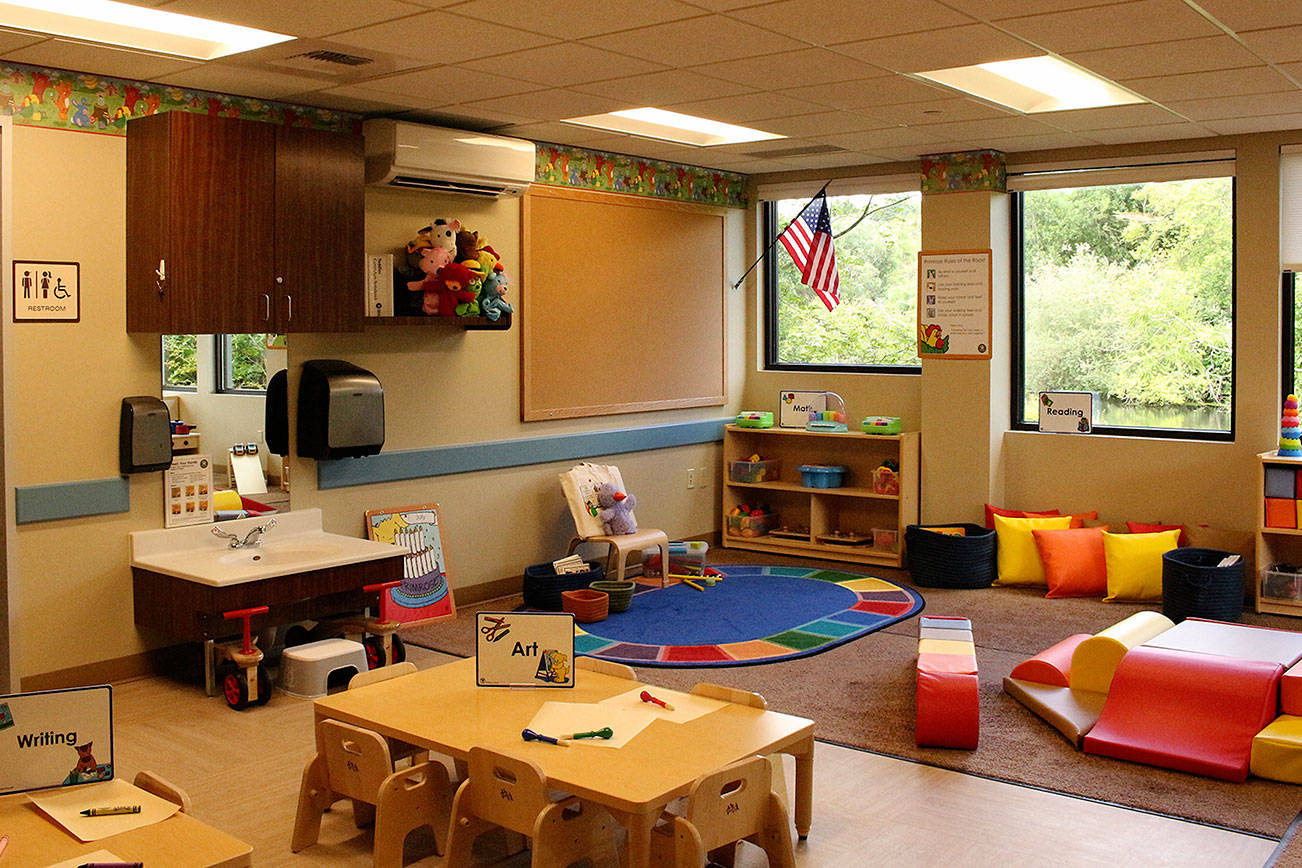The cost of child care has been growing faster than the rate of inflation for the last 25 years in King County, and shows little sign of slowing as parents are stuck spending more of their paychecks on daycare service. A new report released by King County outlines the challenges and gives recommendations for dealing with limited access and rising costs.
“There’s a child care crisis in King County,” said Sarah Reyneveld, chair of the King County Women’s Advisory Board and Washington state assistant attorney general.
Even for Reyneveld and her husband, who works as a prosecuting attorney, the couple shells out more than $50,000 a year for high-end child care for their two children, a cost which has stretched their finances.
“I can imagine for a lot of low-income families this being more of a cost burden to them and a significant challenge,” she said.
The Women’s Advisory Board began its two-year study examining the impacts of child care costs in 2017 and released its findings in a February report. It shows a lack of access to quality child care across the county that impacts families, employers and the broader economy. The reporter also highlights that the low supply of child care providers is failing to meet demand. What providers there are, remain unevenly distributed around the region. Some relief is found in state child care subsidy programs, but they do not offer the same level of assistance to parents who reside in downtown Seattle and those living in rural areas like Omak.
“Omak might be a whole lot cheaper, meaning some families need some additional assistance to deal with a difference in price,” said Karol Brown, member of the advisory board.
Areas with high housing costs subsequently have a high cost of child care, Brown said. High housing costs also push people further from urban centers to find cheaper housing and daycare, contributing to longer commute times and adding to traffic problems.
While families in King County pay more for child care than many places in the U.S., it also has a higher portion of families with children under five who are living below 150 percent of the federal poverty level. That affects women the hardest, but especially women of color, women living in rural areas, low-income and younger women. And while the costs of child care are high, child care providers are some of the lowest paid workers among professions.
The report states the median monthly cost for full-time infant care is more than $1,500, and many families pay even more, averaging about $24,000 annually. Families making 100 percent of the area median income (AMI) are often spending nearly one-quarter of their income on child care, and that is on top of the high cost of housing in the county.
A lack of providers in the Seattle area has created long wait lists, with parents signing up for child care before their child is even born. There are roughly 127,500 children under the age of five in the county, the report shows, but existing child care providers can only handle about half that number.
“We’ve found that the pace of the number of facilities, child care spaces, have not kept up with the population,” Brown said. “Limited supply and growing demand makes the price go up.”
Waiting
For parents like Marilyn Lopez, the birth of her first daughter Sage ( who goes by her middle name Cecilia) meant she had little experience with motherhood, much less the specific parenting challenges found in King County. “(This) wasn’t something I thought about, that I should get on a wait list for child care,” she said. She’s entering her second year of waiting for an open spot at El Centro De La Raza, a bilingual center with locations in Beacon Hill and the International District.
The scarcity meant utilizing nanny sharing, a tactic Lopez discovered on an electronic mailing service she subscribed to after moving to south Seattle from Texas. A family had posted about finding other parents to split the cost of a nanny with. “It’s complete strangers coming together and bringing their kids along,” Lopez chuckled.
Alinne Freitas has seen the effects of the shortage, even in her small, home-based Kirkland center Love Laugh Learn. Her wait list is about two years, and she’s seen an uptick in the number of people contacting her for child care in the last three years, she said.
Part of the shortage of child care stems from a lack of locations where new day cares can set up, she said.
“I don’t think we have enough commercial spaces for day cares because the requirements are so high,” Freitas said.
State help
Additional government funding may help ease the crunch. This is an idea that Adam Hyla Holdorf, communications director for the Children’s Alliance, echoed. While there are several inexpensive ways state and local governments can smooth out the edges, substantial state investment is needed to meaningfully change the state of child care.
“The big changes require a lot of money,” Hyla Holdorf said.
There have been attempts in the state Legislature to provide child care assistance, including a bill in 2018 proposed by Federal Way State Rep. Kristine Reeves. HB 2396 would have provided incentives to employers to increase the accessibility and affordability of child care for working families. It directed the Department of Children, Youth and Families to set guidelines and technical assistance for businesses to help implement child care. It would have also given businesses tax credits for contributing to flexible spending accounts for eligible employees. The bill failed to pass, but Hyla Holdorf said he’s watching as more bills are now before the Legislature.
New bills include legislation proposed by Gov. Jay Inslee to create a child care access work group to develop a way to measure the cost of care. That could be used to determine child care subsidy rates using median income levels, instead of the federal poverty level of about $26,000 for a family of four, when determining eligibility for subsidies.
The second is HB 1351 which would expand access to the state’s Head Start program, a publicly funded Pre-K for families earning an income at about the federal poverty level. It would increase the amount of people eligible to receive services. Because of the high cost of living in the area and generally higher wages than federal poverty levels, only about 8 percent of children in the state can access the program, whereas nationwide about 33 percent are eligible.
Hyla Holdorf is waiting to see if legislators make child care a priority in their budget which will be released next month.
“We came into this session with a strong Democratic majority with ambitious ideas, and right around mid-March we’re going to see both budgets from the House and Senate and what kind of money they are putting behind things like access to affordable college tuition, access to Pre-K,” Hyla Holdorf said.
Another piece of the puzzle is low subsidy rates for families who use the state’s Working Connections Child Care program. It functions similar to Section 8 housing for child care. Families qualify and enroll in the program, and search for a child care provider willing to accept the subsidy. The subsidy rate only pays about 40 percent of market rate for child care, leading many providers to pass on the optional program, Hyla Holdorf said.
“We’re seeing a fair number of providers who don’t participate because the subsidy rate is so low,” he said. “We want to see a substantial investment in raising that subsidy rate.” Boosting the rate to about 75 percent of market rate would require an additional $160 million from the state Legislature.
The state treats child care more similar to college than basic education — like college, child care and Pre-K is largely treated as a private system with modest public investment, Hyla Holdorf said.
“Child care is so much unlike K-12 in the state because we enjoy this universal belief in public education, that everybody should go to school between kindergarten and 12th grade,” he said.
Local
The King County Women’s Advisory Board listed five ways the county could help low and moderate income families find and pay for child care. The first is to create a county Child Care Assistance Program similar to Seattle’s program, which provides vouchers to eligible families who enroll. For the Seattle program, people must live in the city and meet income requirements including being employed or enrolled in job training.
Second, the report recommended the county support the creation of new child care facilities to expand supply and reduce costs. Partial funding could come from $315 million in one-time funds from the Legislature’s 2015 Puget Sound Taxpayer Accountability Account. The county could additionally streamline the permitting process for new child care facilities as part of transit-oriented development associated with Sound Transit 3.
Creating an infants at work program and flexible telecommuting policies for county employees could further help reduce child care costs. The county should let parents bring infants from six weeks to six months of age to work, the report said.
The county should also “inspire and incentivize” employers throughout the county to support families by creating a child care resource website, creating an employer roundtable, supporting employer-backed child care and encourage employers to offer dependent care flexible spending accounts as part of their benefit package.
Finally, the report says a task force should be created to further explore the recommendations and create a report on them by late 2019.
King County Councilmember Kathy Lambert said she had read the report and the county was looking at ways to address it.
“We are grossly in need of more facilities for daycare, and it’s really important that we have places to go to that are predictable and aren’t so expensive that people can’t afford them,” Lambert said.








